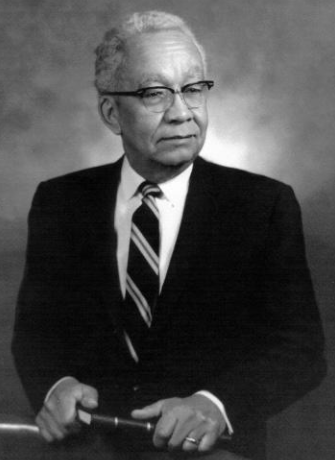Nathaniel Ogelsby Calloway was born in Tuskegee, Alabama, on 10 October 1907, as one of the five children of James N. Calloway and Marietta (aka Mary E., aka Mamie) Oglesby Calloway. His father had been enslaved when young but had gone on to receive a college degree. Calloway began his studies at Iowa State College in 1926, working toward a Bachelor’s of Science in Organic Chemistry, which he received in 1930. During those undergraduate years, he was a member of the ISC Debate Team. Following his B.S. he enrolled in the Organic Chemistry Ph.D. program at Iowa State, working with Dr. Henry Gilman. Calloway earned his Doctorate in Organic Chemistry in 1933, becoming the first African American to receive a Ph.D. in Chemistry from Iowa State. He maintained regular contact with Dr. Gilman via correspondence after completing his degree. Many of those letters are in the Gilman papers in Iowa State University Special Collections. While attending ISC, Calloway lived at 1204 3rd Street, the Walter G. Madison home; 218 Lincoln Way, the Archie and Nancy Martin House; and 2928 Wood Street, the home of ISC alumna Willa Juanita Ewing’s family, the Charles Anthonys.
Dr. Calloway married Henriette Mabel Fulton of Des Moines, Iowa, on 29 August 1933. After graduating, he became a chemistry professor and then Head of the Department of Chemistry at Tuskegee Institute from 1933 to 1935. According to a letter from fellow Iowa State alumnus A. C. Aldridge, Dr. Calloway was present at the inaugural event for Tuskegee’s new President, Frederick D. Patterson, ISC class of 1921 and 1927. In 1936, Dr. Calloway took up a position as an Assistant Professor of Chemistry at Fisk University which he held until 1940. In 1939, he started looking seriously for jobs in industry, because marital problems led to his position being difficult at Fisk with its strict Quaker administration (Calloway, 1939). Following his divorce from his first wife, Calloway married three more times, his last wife being the former Mary Ann Borucki (“Dr. Calloway Dead” 9).
Calloway, seeing no opportunities for advancement at Fisk, left the university in 1940, taking up graduate coursework in the University of Chicago’s Pharmacology Department (Calloway, 1940). His work at the University of Chicago went well initially, though Calloway expressed frustration with how little chemistry was actually involved in Pharmacology. In 1941 he won a 2-quarter fellowship in Pharmacology, was able to be employed during the summer full-time to earn money, and then received an assistantship that allowed him to teach in Pharmacology the next school year (Calloway, 1941). By spring 1943, however, the racism present at the school had begun to chafe; he “ran into so much racial prejudice at Chicago University in regard to clinical facilities” that he decided to leave the school for one “more liberal in its attitude” (Calloway, 1943). He graduated with his M.D. from the University of Illinois Medical School in December 1943.
After that, Dr. Calloway went on to be an Assistant Professor of Medicine at the University of Illinois in the 1950s and early 1960s; Chief of Medical Service at the Tomah, Wisconsin, Veterans Administration Hospital from 1963-1966; and the Madison, Wisconsin, General Hospital, from 1966 until his death on 3 December 1979. When not engaged in medical work, Dr. Calloway was a leader in the African American community in Chicago and nationally. According to Notable Black American Scientists, “his role in reorganizing the Chicago chapter of the Urban League [as its President from 1955 to 1959]…helped transform it from an embarrassment for the national organization to one of its most successful chapters” (Krapp, 1998, p. 54). He later served as the National Director of the Urban League from 1959-1962. When he became a Lecturer in the Afro-American Studies Program at the University of Wisconsin–Madison in 1970, “his…teachings on genetics and race…helped debunk racist notions of white superiority” (Krapp, 1998, p. 54); Calloway argued that “Often what are called racial differences are social and economic differences” (Krapp, 1998, p. 55). Also in 1970, Iowa State University honored Dr. Calloway with a Distinguished Alumni Award. Unfortunately, Calloway’s life was not without controversy. He was ousted from his Urban League Directorship for distancing the organization from early 1960s’ activism, and later, being accused of over-prescribing dangerous drugs to his patients in Madison (Krapp, 1998).
Because of his family’s long association with Tuskegee University, Dr. Nathaniel Calloway is buried in the university cemetery.
Iowa State College dissertation title: Condensation reactions of furfural and its derivatives
Iowa State University Library permalink: https://doi.org/10.31274/rtd-180813-14731
Sources
Calloway, Nathaniel. (1939). Gilman letter, 5 January 1939, Henry Gilman Papers, Iowa State University Special Collections Department, RS 13/6/52, Box 8, folder 8/12.
Calloway, Nathaniel. (1940). Gilman letter, 9 October 1940, Henry Gilman Papers, Iowa State University Special Collections Department, RS 13/6/52, Box 8, folder 8/12.
Calloway, Nathaniel. (1941). Gilman letter, 13 August 1941. Henry Gilman Papers, Iowa State University Special Collections Department, RS 13/6/52, Box 8, folder 8/12.
Calloway, Nathaniel. (1943). Gilman letter, 15 June 1943. Henry Gilman Papers, Iowa State University Special Collections Department, RS 13/6/52, Box 8, folder 8/12.
Dr. Calloway dead at 72. (1979, December 13). Tuskegee News. p 9. Accessed 4 January 2022. http://tkg.stparchive.com/Archive/TKG/TKG12131979P09.php
Krapp, Kristine M., ed. (1998) Nathaniel Oglesby Calloway, in Notable Black American scientists, Gale/Cengage Learning. pp. 54-56.
Biography available at HBCU Connections at Iowa State University : Nathaniel O. Calloway http://hbcuconnections.iastatedigital.org/Nathaniel_O._Calloway
Photo Credit: https://www.blackpast.org/african-american-history/calloway-nathaniel-oglesby-1907-1979/
